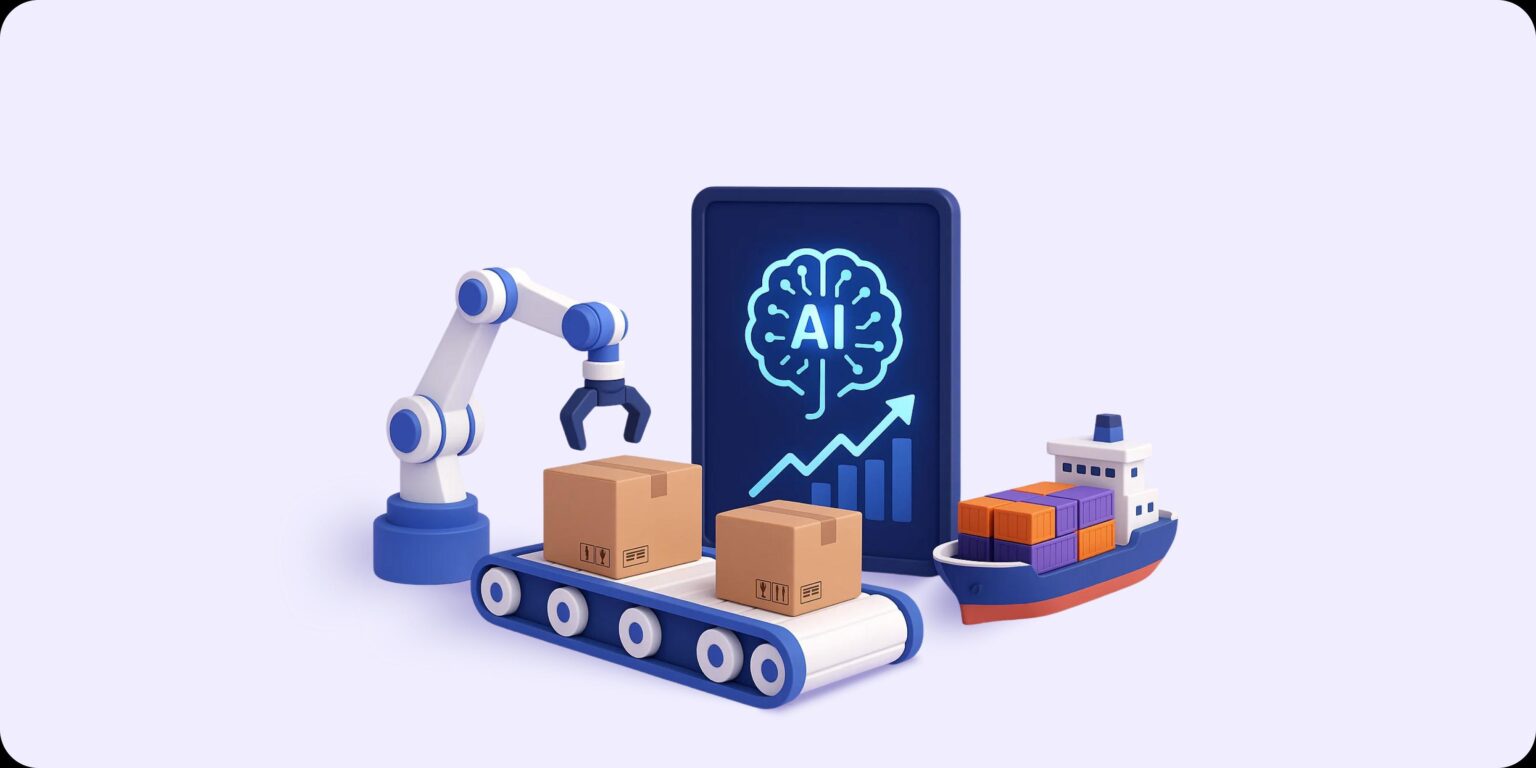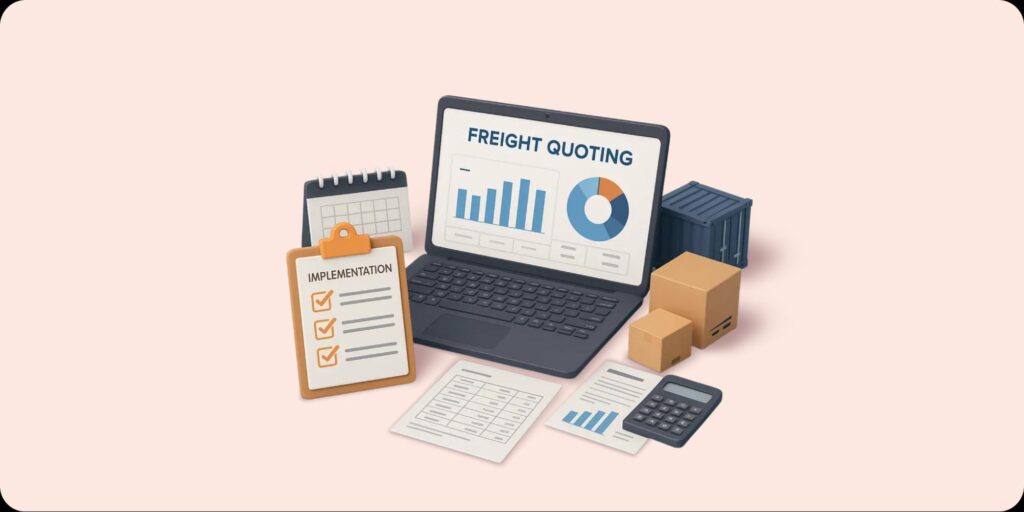Key Takeaways
- AI automates freight operations from quoting to tracking, cutting labor hours and boosting accuracy, productivity, and scalability.
- Predictive analytics improve route planning, reduce costs, and ensure on-time deliveries even during disruptions.
- Real-time visibility tools powered by AI enhance customer experience through accurate updates and predictive ETAs.
- Successful AI adoption requires clean data, phased integration, and employee training to overcome resistance and legacy system challenges.
- Wisor reduces quote turnaround by 85% and boosts conversion rates by automating pricing, routing, and tracking with real-time insights.
AI in Freight Forwarding: Overview
The freight forwarding industry is undergoing rapid transformation due to the rise of artificial intelligence (AI). These technologies are reimagining how goods move across global supply chains.
From booking and route planning to tracking and billing, modern AI tools can automate all these processes end-to-end. By implementing AI, freight forwarders can save significant labor hours, increase productivity, and improve operational accuracy.
In addition, AI systems continuously learn from past shipments, recognize patterns, and optimize processes across the entire logistics ecosystem. Overall, AI technology empowers companies to achieve smoother, more efficient, and scalable logistics operations.
Benefits of AI in Freight Forwarding
AI provides freight forwarders with far more than automation – it adds a layer of intelligence to daily operations. It significantly reduces the margin of error, improves cost management, and accelerates customer service. From route optimization to predictive tracking, AI strengthens every link in the supply chain. Here are the key advantages of AI in freight forwarding:
1. Improves Operational Accuracy and Reduces Human Error
In freight forwarding, accuracy is critical. Manual data entry and document handling can lead to costly mistakes. AI reduces these risks through automated data validation, document scanning, and exception management. Advanced models can identify duplicates, missing data, or unusual cost spikes before they affect shipments, resulting in fewer delays and improved reliability.
2. Enables Smarter Route Planning and Cost Efficiency
Another critical aspect of freight forwarding is route optimization. Until recently, this aspect relied heavily on human experience and intuition. Today, AI systems analyze factors such as weather conditions, port congestion, customs delays, and fuel prices. These insights help freight forwarders minimize transit times and reduce costs. By predicting demand and managing capacity proactively, AI helps maintain profitability even during market fluctuations.
3. Strengthens Shipment Visibility and Customer Experience
Customers now expect transparency and real-time updates. AI-powered tools enhance shipment visibility through integrated tracking and predictive delivery estimates. Freight management systems can share live status updates and arrival forecasts, improving transparency, building trust, and elevating customer satisfaction – one of the most critical success factors in freight forwarding.
4. Enhances Collaboration and Workflow Efficiency
Freight forwarding involves numerous partners, such as carriers, customs agents, warehouse teams, and more. AI facilitates better collaboration by centralizing data into shared dashboards. Real-time access to unified data leads to faster decision-making, improved coordination, and a more connected supply chain ecosystem.
5. Supports Scalability and Long-Term Growth
As shipment volumes increase, manual processes become difficult to sustain. AI addresses this challenge by providing predictive analytics that forecast demand trends and help forwarders adjust pricing, staffing, and routes well in advance. Proactive planning through AI ensures operational resilience and long-term scalability.
Process of Implementing AI in Freight Operations
Implementing AI solutions in freight forwarding requires careful planning and alignment across people, data, and processes, and not just software adoption. The process typically begins with identifying challenges and ends with continuous performance monitoring. Each step helps freight forwarders build a strong digital foundation that supports efficient, data-driven logistics operations:
|
Step |
Description |
Key Outcome |
| 1. Assess Current Operations | Evaluate existing logistics processes, technology, and data systems to identify inefficiencies where AI can add value. | Clear understanding of operational gaps and AI opportunities. |
| 2. Define Objectives and Scope | Set specific goals, such as reducing delivery times, optimizing routes, or improving fuel efficiency. Establish measurable KPIs. | Focused AI strategy aligned with business priorities. |
| 3. Collect and Prepare Data | Gather shipment, tracking, and customer data into one stream. Clean and structure it to ensure accurate analysis and effective machine learning. | Reliable data foundation for AI development. |
| 4. Choose the Right AI Tools and Partners | Select suitable freight automation software like Wisor and partner with vendors experienced in logistics technology. | Access to scalable and proven AI solutions. |
| 5. Develop and Test AI Models | Testing is critical, so build and test AI models in controlled environments before full rollout. | Validation of AI performance and reduced risk of deployment errors, along with improved reliability. |
| 6. Deploy, Monitor, and Optimize | Launch the AI solution, monitor real-time results, and adjust algorithms based on performance and feedback. | Continuous improvement and sustained operational efficiency. |
AI in Freight Forwarding: Key Applications & Use Cases
AI has evolved from theory to a practical, everyday tool in freight forwarding. It now drives efficiency in rate quoting, route planning, and carrier matching, making decisions within seconds that once required hours. Most importantly, AI systems learn from every shipment, improving both accuracy and customer satisfaction over time. Below are some of the most impactful applications:
Dynamic Quoting and Rate Optimization
AI enables instant rate quoting based on live data such as carrier rates, demand, and shipment type. This dynamic pricing approach helps forwarders win more business and avoid underpricing. Automated rate comparisons also eliminate a significant manual workload.
Predictive Route Planning and Delay Forecasting
AI algorithms can predict potential delays caused by factors such as adverse weather, port congestion, or labor strikes. These insights allow companies to reroute shipments proactively and maintain smooth supply chain operations.
Intelligent Carrier and Load Matching
AI analyzes carrier performance, capacity, and route availability to match loads more efficiently. This improves utilization rates, reduces empty miles, and optimizes carrier selection for each shipment.
Real-Time Shipment Visibility and Tracking
AI-driven visibility solutions use GPS, IoT sensors, and predictive analytics to track shipments in real time. Customers increasingly expect this transparency, and freight forwarders that provide it gain a clear competitive advantage in reliability and trust.
Challenges of AI Adoption in Freight Forwarding
Despite AI’s transformative potential, adoption can be complex. Freight forwarders face challenges such as fragmented data, outdated systems, and organizational resistance. Understanding these barriers is key to planning successful AI implementation.
- Data Silos and Lack of Standardization
Many freight forwarders still manage operations across disconnected systems, where booking, invoicing, and shipment data exist in different formats. When data is fragmented, AI models struggle to generate reliable insights. Building standardized data pipelines ensures all systems share consistent structures and enables smooth AI integration. - Integration Complexity Across Legacy Systems
Legacy ERP and TMS platforms were not designed with AI in mind. Integrating new automation tools often requires extensive custom development, increasing time and costs. A gradual integration approach reduces risk and helps companies modernize step by step. - Resistance to Automation and Change Management
Employees, particularly from traditional operations backgrounds, may view AI as a threat rather than a support tool. Fear of job loss can slow adoption. Clear communication and comprehensive training are essential to help teams understand that automation removes repetitive tasks and allows them to focus on strategic, value-added activities. - Balancing AI Efficiency with Human Expertise
While AI enhances speed and accuracy, it cannot fully replicate human intuition in complex logistics scenarios. The most effective approach is to use AI for pattern recognition and forecasting, while experienced professionals handle decision-making and customer interaction.
Best Practices for Adopting AI in Freight Forwarding
After implementing the foundational elements of AI, success depends on how effectively it is managed and integrated into daily operations. These best practices combine human expertise with machine intelligence for sustainable improvement:
| Best Practice | Description |
Expected Outcome |
| 1. Start with Data Quality Improvement | Focus first on cleaning, organizing, and standardizing logistics data. Accurate data ensures that AI models deliver reliable automation and predictive results. | Better forecasting accuracy, fewer shipment delays, and stronger customer trust. |
| 2. Integrate AI Gradually into Existing Systems | Avoid replacing all legacy systems at once. Instead, integrate AI tools in phases, starting with low-risk, high-impact processes and expanding progressively. | Reduced operational risk, smoother transitions, and improved employee adaptation. |
| 3. Train Staff and Build AI Awareness | Educate employees about how AI supports their work, reduces repetitive tasks, and enhances productivity. Encourage openness to digital transformation. | Higher adoption rates, stronger interdepartmental collaboration, and long-term efficiency gains. |
| 4. Start with High-Impact, Measurable Use Cases | Identify specific, measurable use cases, such as automated rate quoting or predictive routing, to demonstrate early ROI and build momentum for adoption. | Faster proof of value, executive buy-in, and scalable implementation success. |
| 5. Maintain Accurate and Consistent Data Pipelines | Establish unified data pipelines that connect shipment, finance, and operations systems to ensure consistency across AI-driven workflows. | Improved data reliability, reduced duplication, and more accurate model outputs. |
| 6. Keep Human Oversight in AI-Driven Decisions | Combine AI recommendations with expert judgment. Humans should validate critical decisions such as rate adjustments, carrier selection, or exception handling. | Balanced automation, fewer operational errors, and preserved decision accountability. |
| 7. Measure ROI and Improve Continuously | Track AI performance metrics such as cost reduction, on-time delivery rates, and process efficiency. Use these insights to refine algorithms and business strategies. | Continuous optimization, data-backed decision-making, and measurable performance growth. |
| 8. Collaborate with Reliable and Experienced AI Partners | Partner with trusted technology providers, such as Wisor, who understand logistics workflows and can tailor solutions to your operational needs. | Faster deployment, better customization, and long-term support for innovation. |
How Wisor Transforms Freight Forwarding with AI-Powered Automation
Wisor is a next-generation freight forwarding automation platform that brings these AI capabilities to life. The platform enables forwarders to automate pricing, routing, and tracking while gaining real-time insights that help teams scale faster and serve customers better. This is how:
- Automates Pricing and Carrier Selection: Wisor uses advanced AI algorithms to compare carrier rates, transit times, and reliability scores in real time. It automates quoting and carrier selection, saving forwarders hours of manual effort while improving accuracy.
- Predicts Optimal Routes to Cut Costs and Delays: Wisor’s routing engine analyzes multiple factors, including weather, port activity, and fuel trends, to predict the most efficient routes. This reduces transit times, cuts fuel costs, and minimizes disruptions across the supply chain.
- Enhances Real-Time Shipment Visibility: Visibility is crucial in freight forwarding. Wisor’s live dashboards keep customers informed through continuous updates and predictive ETAs, improving satisfaction and retention.
- Simplifies Workflows and Reduces Manual Effort: Through deep integration with TMS and ERP systems, Wisor automates document processing, booking, and tracking. These features allow freight forwarders to focus on customer relationships rather than administrative tasks.
- Helps Freight Teams Scale Efficiently with AI Insights: As shipment volumes increase, Wisor’s analytics engine provides real-time insights into lane performance, cost efficiency, and carrier utilization. These insights empower teams to scale efficiently and make smarter, data-backed decisions.
These are valuable benefits that help freight forwarding teams scale confidently and make smarter decisions that are backed by real data.
Conclusion
The integration of AI in freight forwarding marks a major shift for the logistics industry. These technologies enable forwarders to automate tasks, predict delays, and enhance collaboration, allowing them to deliver faster, more reliable services at lower costs.
Organizations that embrace AI-driven solutions early will gain a significant competitive advantage. Today’s customers demand transparency, accuracy, and speed – and companies that meet these expectations will lead the market.
Wisor empowers freight forwarders to achieve this transformation through automation, visibility, and intelligence. If you’re ready to move goods with precision and confidence, AI – powered by Wisor – is the future.








